Rosa Salazar Alita: Battle Angel
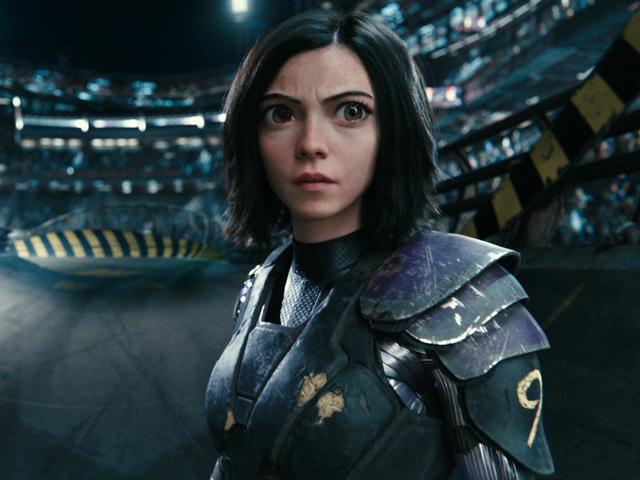
Alita's Battle Begins
Cast: Christoph Waltz, Ed Skrein, Mahershala Ali, Jennifer Connelly, Michelle Rodriguez, Jackie Earle Haley, Eiza González, Casper Van Dien, Jeff Fahey, Rosa Salazar
Director: Robert Rodriguez
Genre: Action, Adventure
Rated: M
Running Time: 122 minutes
Synopsis: From visionary filmmakers James Cameron (Avatar) and Robert Rodriguez (Sin City), comes Alita: Battle Angel, an epic adventure of hope and empowerment, based upon the Manga graphic novel series by Yukito Kishiro. When Alita (Rosa Salazar) awakens with no memory of who she is in a future world she does not recognize, she is taken in by Ido (Christoph Waltz), a compassionate cyberphysician who realizes that somewhere in this abandoned cyborg core is the heart and soul of a young woman with an extraordinary past. As Alita learns to navigate her new life and the treacherous streets of Iron City, Ido tries to shield her from her mysterious history while her street-smart new friend Hugo (Keean Johnson) offers instead to help trigger her memories. But it is only when the deadly and corrupt forces that run the city, headed by Vector (Mahershala Ali), come after Ido and Alita that she discovers a clue to her past – she has unique fighting abilities ingrained in her that those in power will stop at nothing to control. If she can stay out of their grasp, she could be the key to saving her friends, her family and the world she's grown to love.
Alita: Battle Angel
Release Date: February 14th, 2019
About The Production
In the 23rd Century, Earth underwent "the Fall," a shattering war that halted all technological progress and left in its wake a society where every last shred of tech is repurposed and the strong prey on the weak. 300 years later, the heart of life on Earth beats in Iron City, a rich melting pot of survivors--a city full of ordinary people and cybernetically-enhanced humans living side-by-side in the shadow of Zalem, the last of the great Sky cities. Iron City may be an oppressed factory town, cranking out goods for the invisible elites who live in the sky, but it has its own color and energy, its thrills and its aspirants. And now it is about to get an unlikely hero, a teenage cyborg who emerges from a junkyard to discover her identity and become a source of buoyant hope.
With Alita: Battle Angel comes a total sensorial immersion into a world of unbridled imagination, breathless action and visceral emotion. Two of today's leading creators of game-changing movie realms, James Cameron and Robert Rodriguez, have combined their mutual zeal for world-building and empowered female heroines to push the possibilities of visual story-craft into a new zone. They now invite audiences to enter directly into an intricately alive metropolis of the future"and into the high-octane yet heartfelt mission of Alita to fulfill her human potential"forged through an alchemical mix of evocative performances, creative design, state-of-the-art performance-capture technology, CG imagery, VFX and native 3D filmmaking.
The mesmerising adventure begins as cyberphysician Dr. IDyson do makes a scrapyard find that will change his life and Iron City forever: the discarded "cyber-core" of a girl whose body may be broken but her human brain is still barely pulsing with life. Ido cannot abandon her. He begins to restore this mysterious cyborg and discovers a second chance at fatherhood"a chance to watch her learn, grow and taste the wondrous pleasures of life for the first time with wide-eyed excitement. But the sweet, curious girl Ido names Alita hides many secrets. When Alita inadvertently reveals she possesses unique long lost fighting skills, it becomes clear she must carve out her own destiny. For even if the art of the battle was long ago hardwired into her, Alita must discover in her soul the reasons to fight.
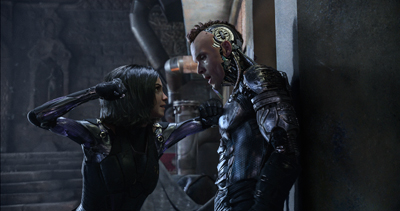 Based on the graphic novel series by Yukito Kishiro, Alita: Battle Angel re-imagines a mythical post-apocalyptical world as a photo-real city full not only of behemoth cyborgs, furiously fast sports spectacles and dark justice but also of compelling human stories. For the filmmakers and the cast of award-winners and new discoveries"including Rosa Salazar, Christoph Waltz, Jennifer Connelly, Mahershala Ali, Ed Skrein, Jackie Earle Haley and newcomer Keean Johnson"bringing it to life was an exhilarating ride.
Based on the graphic novel series by Yukito Kishiro, Alita: Battle Angel re-imagines a mythical post-apocalyptical world as a photo-real city full not only of behemoth cyborgs, furiously fast sports spectacles and dark justice but also of compelling human stories. For the filmmakers and the cast of award-winners and new discoveries"including Rosa Salazar, Christoph Waltz, Jennifer Connelly, Mahershala Ali, Ed Skrein, Jackie Earle Haley and newcomer Keean Johnson"bringing it to life was an exhilarating ride.
Producer Jon Landau, who previously partnered with Cameron on Titanic and Avatar and has been shepherding Alita as the film's hands-on producer from the very start, says: "We hope we've created a new experience for audiences, one that lets you experience the thrill of the movies all over again."
Adds one of the film's visual effects supervisors, Richard Hollander, part of a huge, tirelessly inventive team of designers, artists and digital experimenters who devoted uncountable man-hours to building the bones of Alita's world to give her life: "Alita: Battle Angel pushes a character to a place that's pretty unique in film history. You not only come to believe in Alita as a human being, but you really get to feel like you are part of her experiences in this rich, new world of Iron City."
Plunging the audience full-bore into Alita's deeply felt experiences of beauty and chaos after being reborn in Ido's clinic was always central to Cameron's vision of the film. That idea continued to be a lodestar as Rodriguez took the reins to realize Cameron's vision with his own irrepressible energy and a crack team drawn from both their companies"as well as from the award-winning Weta Digital, which takes the performance-capture technology they pioneered on Avatar to new heights here.
Rodriguez notes that what you see on the screen in Alita: Battle Angel is a result of many combined imaginations synching up, but most of all it is meant to be Alita's vision of Iron City.
"You see this story through Alita's eyes, eyes that have an innocence to them and see the beauty in things," Rodriguez says. "We set out to create something that feels very tactile, that's immersive, that has unexpected moments, all the things you anticipate in a Jim Cameron movie. What's amazing is that Jim has been working on Alita since 1999, but even now, nobody has made anything like it. Making it finally happen has been an incredible process of collaboration."
The fervor, risk-taking and fusing of mind and machine, that drove the making of Alita echo what Alita discovers about pouring your all into what you do. "At its core, this is the story of a girl who gets a second chance at life," says Rodriguez, "and decides this time it will be about following her heart."
Alita Falls From The Sky
James Cameron first fell under the spell of the mysterious Alita almost two decades ago, long before he directed the barrier-shattering 2009 3D science fiction-adventure blockbuster Avatar, which has set the bar for cinematic world-building ever since. In the late 90s, fellow filmmaker and global cinema connoisseur Guillermo Del Toro recommended to Cameron a short anime film based on the nine-volume, cyberpunk Manga series Gunnm by Yukito Kishiro. Del Toro suspected it was right up Cameron's alley.
Indeed, the brew of a fresh vision of the future mixed with thunderous action and themes of exploration, curiosity, self-discovery and a yearning for freedom ignited something in Cameron. He saw in the tale of a young amnesiac cyborg a universal story of discovery and identity and what really matters. The attraction was more the humanity of the story than its 26th Century setting. "I had an emotional reaction to it. I reacted to it especially strongly because my oldest daughter was young at the time and I saw in it a great female empowerment story," Cameron says. "Then I started checking out the books and realized Kishiro had created this an incredibly rich, detailed world full of cinematic potential."
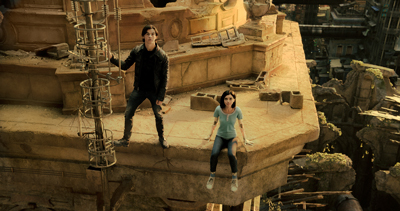 Cameron felt the intricacy of Iron City, this fallen technopolis, could be the ultimate sandbox in which to play with cinematic ideas he'd long hoped to explore, blending the bleeding edge of digital tools with the art of epic, human storytelling. He began a script, fusing story elements from the first four Alita books, and bringing in co-writer Laeta Kalogridis (Shutter Island). In addition to the script, Cameron drafted 600 pages of wide-ranging notes on each of the characters and the life and even the physics of Iron City. He began working with a team of conceptual artists to produce early sketches that became legendary for their photo-real designs that would surely test the limits of computer-enhanced imagery.
Cameron felt the intricacy of Iron City, this fallen technopolis, could be the ultimate sandbox in which to play with cinematic ideas he'd long hoped to explore, blending the bleeding edge of digital tools with the art of epic, human storytelling. He began a script, fusing story elements from the first four Alita books, and bringing in co-writer Laeta Kalogridis (Shutter Island). In addition to the script, Cameron drafted 600 pages of wide-ranging notes on each of the characters and the life and even the physics of Iron City. He began working with a team of conceptual artists to produce early sketches that became legendary for their photo-real designs that would surely test the limits of computer-enhanced imagery. The history of Iron City, and the gleaming presence of the paradisiacal Zalem looming over it, so close yet ever unattainable, was rich with metaphors."The story takes place 300 years after a huge war has devastated the planet and a plague weapon left only a tiny percentage of human survivors," Cameron explains. "Most survivors streamed towards the one remaining sky city, Zalem, the apex of civilization at the time. But Iron City remained as essentially a giant refugee camp. It's full of all these people trying to get to Zalem, to get to the land of opportunity and dreams that they can see but always seems just of reach."
Life in Iron City also intrigued Cameron"this world in which cybernetic body parts are routinely melded with human bodies and brains to create cyborgs of all shapes, sizes and abilities. (Cyborgs are not robots; they're humans enhanced by biotechnological components built into the body.) Today, the cutting edge of medical prosthetics research is pioneering new ways for the human brain to both directly control and sense artificial limbs. But what if the fusion of mind and machine was to make such a quantum leap that it could grant humans the promise not just of restoration but of total reinvention?
"It began because people had to replace limbs due to the effects of the worldwide plague," Cameron explains. "Then, it became a normal way of life for people to have replacement parts. There are no bad connotations to being a cyborg"it can even be a sign of wealth. The highest-end cyborgs are what are known as TRs or Total Replacements. That's when all you have left is an organic, human brain but your entire body has been replaced by parts that are stronger, faster, whatever you aspire to."
Kishiro had, from the very birth of Alita, believed we're already living in an early iteration of a machine-reliant cyborg society. "Even before the internet, we couldn't live without electricity or technology, which makes us similar to cyborgs," observes Kishiro. "We just accept it and try to live our lives, as cyborgs do in Iron City. I think it only puts the emphasis on how can we be more human."
Even when a cyborg's body has been damaged beyond repair, the human brain can live on and be connected to a new body, which is why Dr. Ido is able to save Alita. But the fact that Alita has no clue who she is, where she comes from, or what her life story is, sparked Cameron's imagination further.
"When Ido rebuilds her, Alita has no memory. She's completely open and curious about a world that's new to her," says Cameron. "But as she finds out more about herself, she becomes a more complex character, one who is not only looking for who she was but must decide who she wants to be."
Alita's innate fearlessness, programmed into her long ago when she was built on the human space colony known as URM (United Republic of Mars), became the catalyst for deepening her character. "Alita has no fear for herself. It doesn't matter how big or menacing an opponent, she just goes right at it. Now that's a hard character to write because you have to find a vulnerability," Cameron says. "I came to realize her true vulnerability is that even though she'll never fear for herself, she does fear for the people she loves. So the story became about Alita's bonds, betrayals and all she learns about human nature."
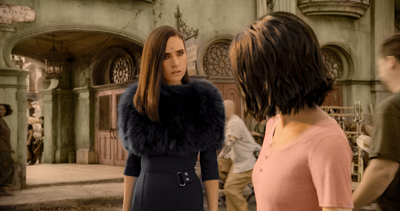 Landau recalls that Cameron's draft was a starkly emotional read. "At its heart were two love stories: a love story between Alita and Ido, the father figure who rebuilt her, and a love story between Alita and Hugo, a street kid and cyborg jacker who never thought he'd fall in love with a cyborg."
Landau recalls that Cameron's draft was a starkly emotional read. "At its heart were two love stories: a love story between Alita and Ido, the father figure who rebuilt her, and a love story between Alita and Hugo, a street kid and cyborg jacker who never thought he'd fall in love with a cyborg." Ardent fans couldn't wait for Cameron to tackle the Manga. But by the mid-2000s Cameron stood at a fateful crossroads: forced to choose between his two creations, to go all-in on either Alita or Avatar. It goes without saying that he took the path of Avatar, sensing the technology was ready to be pushed where he needed it to go. But the exponential leap that followed would also make Alita possible.
Cameron never stopped dreaming about giving life to Alita. Yet the worldwide hunger for Avatar sequels kept him expanding that universe and he saw no clear space for Alita on the horizon. It wasn't until one day when he was talking with his good friend Robert Rodriguez that it came to him that he would feel comfortable passing Alita on into the right hands"into say, Rodriguez's hands. Cameron and Rodriguez often had stimulating conversations about cinematic techniques, but now Cameron had the idea of going further, of inviting his friend to be creative partner on this project he held so closely.
"It happened in a split second when I thought, 'I would let go of Alita for Robert.' He has the energy, the creativity, he's done tons of effects stuff, he's great with kick-ass action, and I also felt he could tap into some of that outrageous sensibility that Battle Angel occasionally needs."
Sensing a passing of the torch, Cameron sent Rodriguez his script. Recalls Cameron, "Robert called me a couple days later and said, 'Man, I've got to make this.'"
Lightstorm Meets Troublemaker
While Cameron is renown for some of cinema's most sweeping epics, from Terminator to Titanic to Avatar, Rodriguez cut his teeth in the indie world by making madly inventive, hyper-vivid action thrillers on lean-and-mean budgets, often writing, directing and shooting them himself. After gaining acclaim with the micro-budget El Mariachi at age 23, he continued cultivating his creative freedom and high-energy style on such hits as Desperado, Once Upon a Time in Mexico, Sin City, Machete and Planet Terror, as well as becoming an early 3D innovator with the Spy Kids series of family films.
There was little doubt that he had the kind of extreme commitment to vision required but Alita: Battle Angel would take Rodriguez into a whole new scale of production. It would also take him to his very favorite place: way outside even his wide-open comfort zone.
A long-time fan of the Kishiro books, Rodriguez says he was hankering for Cameron to make the movies. "I'd been dreaming about it and waiting for it," he muses. Yet, when Cameron asked him to step into those shoes and realize the dream on his behalf, it was irresistable. Rodriguez loved how the initial script took the world Kishiro created and, while staying true to the spirit of it, translated it into a Cameronesque tale of love and adventure. "I identified with Alita. I identified with Hugo. I identified with all the characters"and that's what Jim does amazingly well," he says.
The meticulous work Cameron and team had already done gave Rodriguez a home base from which to blast off in his own way."Jim's thing is making sure even the most sci-fi elements believably work," says Rodriguez. "He'd already figured out how every part of Iron City would operate from an engineering POV. So from the start, nothing felt imaginary. It was ready to come to life."
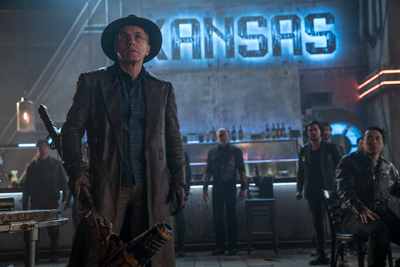 Every frame of art Rodriguez saw, from the sun-washed, color-splashed streets of Iron City to the cyborgs whose machine bodies were infused with human qualities of charm, humor and hubris, spoke to him. The chance to play with all the tech Cameron, Lightstorm and Weta had invented for Avatar"the facial performance capture system, the Simulcam system for superimposing digital characters onto actors in real-time, the 3D Fusion Camera system and more"was also a strong magnet for Rodriguez.
Every frame of art Rodriguez saw, from the sun-washed, color-splashed streets of Iron City to the cyborgs whose machine bodies were infused with human qualities of charm, humor and hubris, spoke to him. The chance to play with all the tech Cameron, Lightstorm and Weta had invented for Avatar"the facial performance capture system, the Simulcam system for superimposing digital characters onto actors in real-time, the 3D Fusion Camera system and more"was also a strong magnet for Rodriguez. A playful innovator who enjoyed blowing past conventional boundaries from the start, Rodriguez had already been a 3D pioneer"his Spy Kids 3D became the first all-digital movie in 2003, Now, he was like a kid let loose in the ultimate cinematic candy store. "Tech has always been a big part of what I do," says Rodriguez. "But with this film, I knew I would have a chance to go exponentially further because Jim has already innovated so many different technologies for visualizing, pre-visualizing and making 3D films. I took it as a real chance to learn. I knew I'd be really challenged, which I thought was fantastic."
Throughout the process, Rodriguez says, he was hoping to channel a whole lot of Cameron. "I tried to ground the story in reality the way he does. I tried to honor his style because that's what I always wanted: to see Jim Cameron's Alita." As the project got underway, a constant flow of ideas and knowledge passed back-and-forth between the two men, as each compelled the other to up the creative ante.
So too was forged a catalytic merger of the minds between Rodriguez's Austin-based Troublemaker Studios and Cameron's Manhattan Beach-based Lightstorm Entertainment. Landau notes that this cross-pollination inspired everyone: "We learned from Troublemaker while Robert learned a lot from the team of artists who had worked on Avatar that we've had long had around us at Lightstorm Entertainment. It was a just a great, creative symbiosis between our groups."
Life imitated art and vice versa as this movie about human-machine interfaces incited hundreds of artists to head for the edges where live action and digital filmmaking fuse into one aesthetic.
Cameron was gratified to see Rodriguez tackle the project with all the gusto and gutsiness he knew he'd bring. "It's been exciting to watch because I can see Robert loves the process, he loves the technology, he loves the design elements, and he's insanely collaborative," says Cameron. "He was very respectful of Kishiro's world and also of what I had written, yet not afraid to make it his own. I wanted to give him as much space as he needed creatively and I was emphatic about that from the beginning."
In early days, Rodriguez decided he would build from scratch the heart of Iron City"later to be extended digitally into a full-scale metropolis" on Troublemaker's backlot, by far the most ambitious build in its history. "I wanted to build the first level of the city, the old bones of the city, and then Weta could take it the rest of the way up. I loved that I could step out of my office and be in Iron City."
When Yukito Kishiro visited the set, he could not believe where his hand-drawn Manga had led. The moment was dizzyingly surreal as he walked entrancing streets that once existed only in his mind's eye. "It was truly like a dream," says Kishiro. "I'm so honored by what James and Robert created."
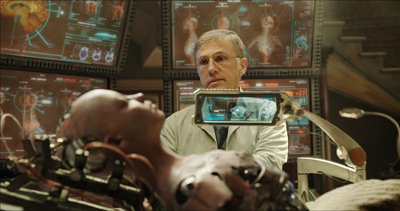 Embodying the Characters
Embodying the Characters When Alita re-awakens to a brand-new life in Iron City, she goes through a series of intense transformations. She begins as a nearly blank-slate, devoid of memories, so that even the sour tang of an orange peel electrifies her taste receptors. With no clear identity, she wonders if she is just an "insignificant girl" who has no real purpose, no real family, even as she begins to forge fledgling bonds. Then, when she discovers the body that was intended to be hers" the so-called Berserker body that has faculties the likes of which Iron City has never seen, Alita has to contend with a whole different idea of her destiny. Ultimately, Alita realizes she is definitely not going to be an insignificant girl, and she refuses to be just the weapon of destruction that the Berserker body was created for. Instead, she turns herself into a passion-fueled instrument for justice.
A massive casting search ensued to find someone who could embody all this"a diminutive person with a mammoth persona, with both high-flying moves and the sheer force of a bright and openhearted spirit. There were no particular criteria as Alita. As Kishiro wrote in the Manga, Iron City is not so much a nation as a last outpost of humanity; and Alita herself was born in a human colony on Mars. What mattered most was believability. After all, tiny Alita must stand up to 13-foot tall cyborg brutes, so the audience had to trust not only in her battle virtuosity but in her growing confidence and determination to both understand the vastness of her power and use it wisely.
After endless casting calls, the film's Alita revealed herself in Rosa Salazar, the Canadian-born Cuban-American who has been seen in the Insurgent and Maze Runner series and in the thriller Bird Box. Here, she would have to carry an entire movie on her shoulders, but everyone intuited she would rise to the challenge. Cameron recalls: "It's almost impossible to quantify just how big the reaction was that Robert and I had to Rosa. She brought such heart and vitality to every moment. I've never seen anything like it."
Adds Rodriguez: "It's like a dream when someone walks in the door and you see that thing you were looking for that you couldn't even describe. That's what happened with Rosa. It was magic."
The massive search ground to a halt in an instant, explains Landau. "Once we saw Rosa, there was nobody else in our minds who could ever play the part. She brought such a purity and joie de vivre to her performance. And while she can make you believe in the crazy strength of the Berserker Alita, no matter what she is doing, Rosa never loses sight of the compassion that makes Alita so unique."
Salazar knew she'd be walking a tightrope in the role"so she thrived on the safety net provided by Cameron and Rodriguez. "Jim explained all the nut-and-bolts of Alita to me, but also, Jim has such tenderness towards Alita and that gave me a lot of insight. And with Robert I felt an immediate artistic and human connection," she says. "He's so energetic and always creating, yet his demeanor is calm. When he listens to you, he really hears you. I always felt my words had weight with him."
Months before production began, Salazar leapt into intensive training, studying the demanding arts of Wushu, Muay Thai and Kung Fu, and honing her inline skating repertoire as well. "The training almost killed me," she admits. "I had to get my endurance way up, build lots of strength and start to think like a regimented warrior. A lot of it was learning the forms, harnessing that energy and rhythm."
Though Salazar did some of her own stunt work, the overwhelming complexity of the shoot necessitated having up to nine different "stunt Alitas" in play, including world-class gymnasts and contortionists. "Alita kicks a lot of ass and she kicks the asses of huge, enhanced cyborgs," Salazar muses. "What I like about her fierceness is that I think it gives girls permission to realise you can be both soft and brave, you can express your emotions but also be determined never to let evil win."
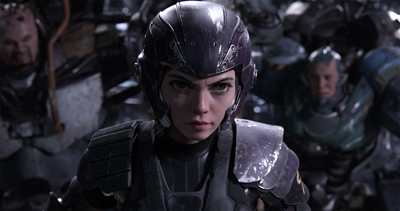 Things notch up further when Alita finds her Berserker body"a sleek, iridescent work of biomechanical art with a complex network of neuronal connections that morphs to her subconsicous. "Alita's body change is a kind of metaphor," says Salazar. "She's starts out as an awkward teen, then she becomes a strong, capable young woman with the Berserker body. When she does, it's like, 'Finally. This is my true skin.'"
Things notch up further when Alita finds her Berserker body"a sleek, iridescent work of biomechanical art with a complex network of neuronal connections that morphs to her subconsicous. "Alita's body change is a kind of metaphor," says Salazar. "She's starts out as an awkward teen, then she becomes a strong, capable young woman with the Berserker body. When she does, it's like, 'Finally. This is my true skin.'" Alita comes to feel deeply grateful to Dr. Ido, the brilliant cyberphysician who uses his medical training to help the needy of Iron City, even while prowling the night as a hunter-warrior. It is Ido who, in trying to assuage his own emotional pain over the loss of his own daughter, gives Alita a warm, loving home where she is free to explore her true self. As a father, Rodriguez related to Ido. "I identified with Ido trying in some ways to control her but also learning to trust her and let her go, believing that she will make the right choices," he says.
Rodriguez had one actor in mind for the poignant action role: two-time Academy Award®-winner Christoph Waltz. Though Waltz has a way with the sinister, here his character is driven by decency. Rodriguez liked the idea of pairing Waltz with a scientist character. "When Christoph says something very technical, you listen to every word, and it doesn't sound technical anymore. So, I thought we have to get this guy. I could never imagine another person playing Ido, so we got lucky that he agreed to do it."
"Christoph can say a thousand words with a single facial expression," comments Landau. "He brings to Ido a mix of compassion with intellect that is going to be relatable for audiences all over the world."
Waltz was convinced via conversations with Cameron. "We talked a lot about this being the story of a father coming to terms with his daughter's independence, realising he can't always protect her. And I think that's what most excited Christoph about the role," Cameron explains.
Iron City also held an allure for Waltz, as a warning. "I found it to be an attentive observation of a society where there's no room for civility, where everybody's out for himself," Waltz says.
Waltz says another draw was the fact that Alita: Battle Angel felt so opposite to the kind of movies to which he's usually drawn, and he liked making a complete left turn from the expected. "I like Robert's whole approach to moviemaking because it's on the other side of the spectrum from where I am as more of a traditionalist. He's a master of the digital way of shooting movies, which is a whole different mindset for me. But I found it is simply a completely different art form in its own right."
Once he settled into the process, Waltz made a very deep human link with Salazar, which became a linchpin of the entire production. "What Ido and Alita go through had to feel real," says Salazar. "They go through all of the moments that a father and daughter go through: the struggling, the love, that moment of the bird leaving the nest. And it had to all based on love like any real father-daughter relationship. It's something really beautiful: Alita replaces a piece of Ido's broken heart and in return he gives her life. I felt so lucky because Christoph has such a raw, innate ability to take on characters. We had these amazing conversations together and he inspired me the whole way."
Just as vital to Alita's evolution is her first love Hugo, who unlike Alita, is highly adapted to life in Iron City as a non-enhanced human. He has honed his self-reliance to a sharp edge, to the point that it's a revelation to him to learn to live for somebody else. Casting Hugo was another crux for the production. Audition after audition left the filmmakers unconvinced until newcomer Keean Johnson came in and nailed the essence of the character.
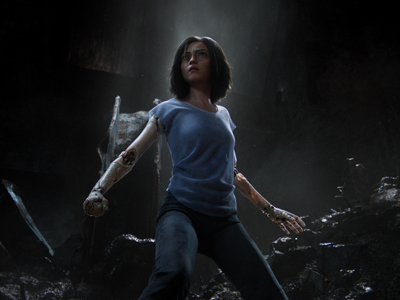 "Keean captured just the right balance between vulnerability and the toughness that allows Hugo to survive. Watching this young man mature into a refined actor over the course of production has been really exciting and he's added so much to the feeling of the movie," says Landau.
"Keean captured just the right balance between vulnerability and the toughness that allows Hugo to survive. Watching this young man mature into a refined actor over the course of production has been really exciting and he's added so much to the feeling of the movie," says Landau. "It was hard to find someone who could match Rosa's intensity and focus," notes Rodriguez. "Keean felt very much like the kid in the Manga: a wide-eyed dreamer with a cool, mysterious quality to him, but he also came through with the emotionality. More than that, he brought something out in Rosa. And then she brought more out in him. There was that classic chemistry between them."
Right away, Johnson felt a link to Hugo's tenacity, as he keeps aiming at his sky-high dreams no matter how impossible. "Hugo's had to be a hustler to survive in this tough, tough world," he observes. "He could have gone the route his father did as a factory worker, but he's driven by the hope of getting to Zalem, which has led him to do things he isn't proud of. Even so, there's a lot of good to Hugo. He's passionate, open-minded and when he puts his mind to something, he expects to accomplish it."
As it turns out, Hugo is also a "jacker," an Iron City outlaw who takes cybernetic body parts by force"a dark truth he tries to keep from Alita. "Hugo believes jacking is his way to Zalem, but when he falls in love with Alita, he is no longer sure if Zalem is worth it to him," says Johnson.
Hugo certainly doesn't expect to fall for a cyborg, but Alita's exuberance about the world is intoxicating. When he teaches her to play street Motorball, only to watch her excel beyond his wildest fantasies, his heart takes off racing. "Motorball is Hugo's game, so when he sees her incredible talent, it blows him away. But he also sees such a pure soul in Alita," Johnson comments.
Johnson says his connection with Salazar felt organic from day one. "Rosa and I really vibed off each other. We were friends from the start and we had these incredible talks that cemented our bond."
Hugo may not have the enhanced physicality of a cyborg, but he has his own skills. He knows every secret alley and shortcut in Iron City. Then there's Hugo's gyrobike, an amped-up, aggressive, single-wheeled version of a motorcycle. "When I first saw it, I thought it was the coolest thing ever," Johnson confesses. "I assumed I'd be doing that on a green screen, but when they put me on a rig that could move by remote-control any way I leaned, it made the role that much more fun. The whole production was designed to immerse the actors so far into this world."
The more Alita reveals about who she is, the more she also develops enemies across Iron City. One of the first to recoil in her presence is Dr. Ido's ex-wife, Chiren, also a skilled cyberphysician, but one who has turned grief into the pursuit of money and power in the high-stakes world of Motorball. Chiren is aghast to see that the body Ido used to give Alita a new chance at life was the one they designed for their now-deceased daughter.
Taking the role of a complicated woman running from pain and seeking a way home is Academy Award®-winner Jennifer Connelly.
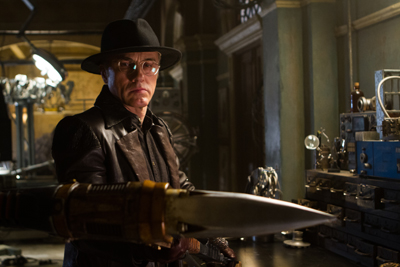 Connelly views Chiren as longing for a path back to joy."She was born in Zalem so she sees returning there as a kind of magic balm for her life, a way to escape her memories of grief and loss in Iron City. She wants to be transported away with every part of her being and there's no way she's going to surrender to existence in Iron City. Her extreme drive is a measure of her desperation and bitterness."
Connelly views Chiren as longing for a path back to joy."She was born in Zalem so she sees returning there as a kind of magic balm for her life, a way to escape her memories of grief and loss in Iron City. She wants to be transported away with every part of her being and there's no way she's going to surrender to existence in Iron City. Her extreme drive is a measure of her desperation and bitterness." In an indelible moment, Chiren's iced-over heart almost cracks when she first catches sight of Alita. "She sees this intricately carved, beautiful cyborg body Ido had made for their daughter…only it's not their daughter she sees," notes Connelly. "Chiren immediately perceives Alita as a threat because she brings up all this pain she doesn't want to confront. And she also starts to realize that Alita is going to disrupt Iron City and challenge all the institutions that still exist there."
Yet, Chiren cannot fully hold at bay the feelings Alita spurs in her."There are emotions she can't deny anymore. She experiences something like a thaw when she realises she's trying to kill someone who looks like her deceased daughter. It's a moment when Chiren recognises she's become all that she abhors," says Connelly. "And from that moment forward, things move in a different direction."
Chiren has allied herself with one of the darkest forces in Iron City: Vector, who has amassed great influence as the city's top broker of cyborg parts. Mahershala Ali was cast as Vector before he had won a Best Supporting Actor Oscar® for Moonlight. "I always felt we needed somebody really charismatic, because all the street kids look up to Vector," says Rodriguez. "Mahershala impressed me already in 2010's Predators, and we watched as he grew more and more."
Vector, who is 100% human, views himself as an elite and looks down upon the striving masses of Iron City. "Vector has fully absorbed that only way to win in Iron City is to prey upon the weak," Ali explains. "He'd rather be a king in hell than be at the bottom of the totem pole in heaven."
His need to stay on top makes Alita an immediate adversary. "Vector will do anything in his power to not lose his status," says Ali. "He craves control, and Alita's way too much of a wild card."
Still, though Vector lives better than most in Iron City, the truth is that he's given up his freedom in exchange, allowing himself to be overtaken by the mysterious Nova, an entity on Zalem with the ability to inhabit Vector's body. "Vector is a villain but it turns out he's really just following orders," notes Ali. "The plans are all being dictated by Nova and Vector is sadly just his pawn."
Alita soon learns she is not the only cyborg in Iron City. In fact, large portions of Iron City's denizens have cyborg parts. Even cyborg dogs roam the streets. But what she does not know is that she will become the target of the city's most feared cyborgs, including the colossal Grewishka. A fallen star of the Motorball games, raised in the sewers of Iron City, Grewishka has never known anything but darkness and fighting for whatever he can get, which along with his super-charged frame of parts, makes him the ultimate henchman for Vector. His body goes through several iterations: growing larger and larger each time he must be rebuilt, becoming a massive metal gargoyle, but always plastered with his synthetic face, a reminder of the human within.
The casting of Grewishka was unexpected, as Oscar® nominee Jackie Earle Haley, not a behemoth himself, took the role. It was Haley's ability to make Grewishka's roiling persona real that interested Rodriguez. "Grewishka could be this big, dumb brute, but Jackie gives him a lot of color and pain. People can't believe this huge presence is Jackie, but you see Jackie in all the nuances," Rodriguez says.
Haley found empathy for Grewishka. "He's had this horrible, tortured life," Haley explains. "The only way that he actually derives happiness is through having this enormous, powerful body and the only way he can find self-esteem is by abusing others. That psychology runs deep in him."
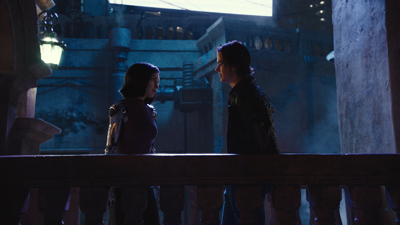 Also posing a grave danger to Alita is the total replacement cyborg Zapan, with his sleek, high-tech body replete with synthetic skin. Bringing Zapan to life is Ed Skrein, known for such roles as Daario Naharis in Game of Thrones and Ajax in Deadpool. "Ed is just so swaggery," says Rodriguez. "As far as he wanted to go, I would say go further and we just had a gas. Zapan is one of my favorite designs, too, because he looks like a Porsche. He's so ornamented up."
Also posing a grave danger to Alita is the total replacement cyborg Zapan, with his sleek, high-tech body replete with synthetic skin. Bringing Zapan to life is Ed Skrein, known for such roles as Daario Naharis in Game of Thrones and Ajax in Deadpool. "Ed is just so swaggery," says Rodriguez. "As far as he wanted to go, I would say go further and we just had a gas. Zapan is one of my favorite designs, too, because he looks like a Porsche. He's so ornamented up." Sharp as his wit is, Zapan is most renowned for his Damascus Blade, an ancient URM-built sword that can slice through armor like butter. Skrein could not help but be intrigued by the hunter-warrior's vanity. "Zapan is an ostentatious, almost theatrical person," he describes. "Most hunter-warriors are dirty and rusty, but Zapan prides himself on his ornate body. He's a dangerous mix of ego and insecurity."
Weta Digital and The Frontier of the Human Face
No decision was needed to bring Weta Digital on board Alita: Battle Angel; it was simply a given. From the lush wonders of Pandora in Avatar to Gollum in Lord of the Rings to the sentient primates of Planet of the Apes, Weta has propelled nearly every performance-capture milestone of the last two decades. In particular, spurred largely by Cameron's aspirations for Avatar, Weta has revolutionized real-time digital capture of the human face, allowing for an actor's natural expressions to be fully mapped and translated"the stuff of raw emotions intact"into CG animation. They remain the leaders of the field.
Says Cameron, "Weta still does the best facial animation of anybody out there"the most human, the most alive, the most emotional. So many other houses are trying to catch up, but Weta remains in front. I knew they had to do Alita, because you have to believe in her even in the tightest close-ups."
Weta has kept surging forward since Avatar. Every aspect of their distinctive process has progressed, from more efficient workflows to more versatile digital lighting to an improved ability to simulate muscles and skin. This was all vital to infusing Salazar's performance into Alita's CG body and to blending the blistering action and emotional drama that had to feel equally real in the visuals.
Senior visual effects supervisor for Weta Joe Letteri elaborates: "What Jim did that was so prescient on Avatar was to break down the barrier between live action and digital filmmaking, showing that they could integrate in ways no one had previously attempted. On this film we're taking that integration even further because we're in a live action world that has digital characters brought into it."
Weta's knowledge and command of the human face has also become deeper with every production, reaching a new zenith with Alita. "I've worked with digital faces on many films, but I've never seen faces like these," says animation supervisor Mike Cozens, who also worked on Avatar.
For Alita, Weta orchestrated a new level of CG facial sophistication. Explains Eric Saindon, visual effects supervisor for Weta and a two-time Oscar® nominee for The Hobbit series: "We're now able to work at the level of the facial musculature"so it's no longer about just moving the surface skin but moving the underlying muscles. You can see it in how the movements of Alita's face look so much like Rosa's. We spent hundreds and hundreds of hours just working with Alita's mouth, because what makes even a big action scene work is getting the most human expressions and Rosa has a very expressive face."
He continues: "We're also constantly working on the performance capture system to get higher and higher fidelity, so there are many little subtleties you see in Alita that you wouldn't have seen in Avatar or Planet of the Apes. It's those little natural details that create that extra feeling of life."
There was also zero doubt going in that the film would be shot in native 3D. "The best 3D is native 3D, you can't just convert it later," says Cameron. "Luckily, Robert had shot native 3D before, so he was completely familiar with the rigs and how they work."
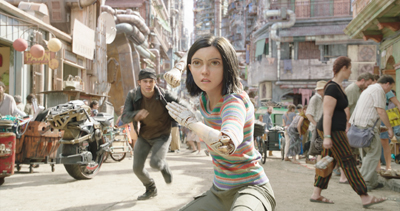 Rodriguez was indeed familiar with the basics, but he was exhilarated by how systems have leapt ahead. "The advances have been incredible over the last few years. I even forgot at times we were shooting with 3D cameras on Alita because they don't slow you down at all anymore," he says.
Rodriguez was indeed familiar with the basics, but he was exhilarated by how systems have leapt ahead. "The advances have been incredible over the last few years. I even forgot at times we were shooting with 3D cameras on Alita because they don't slow you down at all anymore," he says. Both Cameron and Rodriguez share the view that 3D is just another tool in the filmmaker's toolbox"a powerfully immersive tool but still in service to the storytelling. Editor Stephen Rivkin, an Oscar® nominee for Avatar, sums up: "Jim has always maintained that 3D must be an element of the story and not the star of the story."
Building Iron City
From the earliest stages of imagining Alita, James Cameron had a vision of putting audiences inside the tumult of Iron City, a 26th Century city reeling from war 300 years prior and but also pulsing with life. He always envisioned a deeply layered place of abundant contrasts, at once a cyborg-filled Wild West of rampant crime and bounty hunters, but also a place where Alita experiences the thrill of discovery, love, elation, street life and the inspiration to change the city for the better. No matter how tough times have become in Iron City, the human instinct for fun, for art, for achievement and for joy still runs rampant.
"Iron City is the place that people have come from all over the world to find sanctuary. So it's an ad hoc kind of slum superimposed on the high-tech world that existed there before the war. It's dangerous but it also has this amazing, chaotic energy," says Cameron.
Iron City also evokes a whole history of evolution and devolution, with hints of sophisticated technology falling into disarray. "You can feel the disparity between the technology that was created before the war but is still in use, and the living conditions that people now endure," says Cameron.
For technical reasons to do with Zalem's seemingly "magical ability to hover in the sky above the bustling and teeming iron city and the space elevator that once connected it to earth, Cameron chose to present Iron City as an equatorial city, somewhere in South America, though more a melting pot than representative of a singular nation. That concept hit home with Rodriguez. "Kishiro didn't set Alita in Asia," he notes. "He had Kansas in mind, but years ago Jim realized that for scientific engineering reasons, Iron City would realistically have to be closer to an equator. I loved that because it instantly gives you more color and richness than you've seen in a sci-fi story. Iron City isn't dreary and gray. It's inviting, vibrant and full of diversity."
The construction of Iron City began on paper, with the production's voluminous concept art started a decade ago. Ben Procter and Dylan Cole, co-production designers on the Avatar sequels, took on the challenge of serving as concept design supervisors for Alita: Battle Angel. Says Procter: "The mandate for Iron City was to bring out lots of energy, intensity, street art and the feel of classic, timeless architecture melded with influences from the high-tech world before the Fall."
Adds Cole: "It was important to us that Iron City have a futuristic culture unlike any you've seen before.We've seen so much rain-slicked, neon-lit sci-fi and the fact is, you can't top Blade Runner in that regard. So we wanted a completely different kind of tone. We've created a dusty, sundrenched look for Iron City that suggests that life goes on in this place despite the oppression people are living under."
The concept art moved all who had the chance to see it, but the task of turning these bold and lyrical paintings into functional sets on the backlot of Troublemaker Studio was going to be massive. That's why Rodriguez brought in a team that has always been undaunted by any creative mission: production designer Steve Joyner and his colleague Caylah Eddleblute, who have been working with Rodriguez since Dust Till Dawn. Says Rodriguez: "Steve and Caylah figured out how to turn Troublemaker's lot into a textured city that took on a life of its own. They used secret tricks to make eight streets feel like an entire world. It helped ground everything. It anchored Alita in that palpable reality that we absolutely needed."
The pair's simpatico knowledge of Rodriguez was an advantage. "We knew going in that Robert is all about depth. We knew he would want a city that seems to go on forever," says Joyner. "So we knew we had to create an intricate network of streets, allies and corridors that all interconnect. Ultimately, the sets were so complex there were nooks and crannies even Caylah and I didn't know were there!"
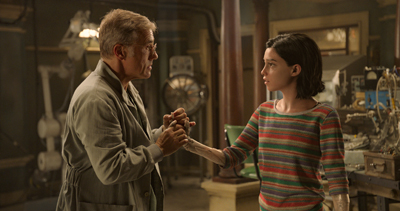 The sets demanded all manner of logistical parameters"each space had to be constructed to accommodate the unwieldy performance-capture process. But the main focus was on something else: to generate an environment visceral enough to transport the actors to a fresh reality.
The sets demanded all manner of logistical parameters"each space had to be constructed to accommodate the unwieldy performance-capture process. But the main focus was on something else: to generate an environment visceral enough to transport the actors to a fresh reality. Joyner and Eddleblute's approach to the future boiled down to one phrase: "What does the future look like? It looks like the past with the future layered over it." Eddleblute elaborates: "Times change, but many things stay the same. The film is sets hundreds of years in the future, but if you look back at life 400 years before today, people still sat in a chair to eat breakfast in the morning, just as we do. So we thought a lot about using everyday objects to make Alita's world feel accessible and relatable to us now."
Joyner and Eddleblute began forging this imaginary realm by researching Panama and Cuba, taking in the colonial architecture, the cosmopolitan vibe, the barrios and the fusion of modernity and history. Then, they imagined what would happen if a South American city was suddenly jam-packed with people from every corner of the globe. "Because so many people came to Iron City from all over after the war, it had to feel like an amalgamation of cultures blending together," says Joyner.
When it came time to erect the city, they enlisted more than 200 carpenters, painters, plasterers and craftspeople to join them in Austin for an unprecedented adventure. "This kind of build happens once in a career," notes Joyner," and it felt like an amazing gift to share that."
Landau recalls Alita creator Kishiro's first visit to the set. "Kishiro is a man of very few spoken words, but when he walked out on the set of Iron City, the smile on his face said more than any words could."
One of the first locations audiences encounter in Alita: Battle Angel is the scrapyard where Dr. Ido spies the discarded Alita. As the origin moment of the entire fabled story, it needed to have a tinge of the mythic to it, so Joyner and Eddleblute carefully built the scrapyard out of metal and mechanical detritus sourced at a military salvage yard in San Antonio. "We brought in huge crates of various scales of scrap from chunks of metal to the finest material that literally could fall like rain," says Eddleblute.
Ido's clinic and lab have a decidedly cludged together, low tech feeling. "It's an open space that was once a hotel or bank lobby," describes Joyner. "Now it serves as everything to Ido: his living quarters, office, kitchen and surgical suite all in one room, which is a very Central American thing to do, and also again gives Robert that thing he loves most: depth!"
Chiren's lab contrasts starkly with Ido's lab, highlighting the split in their philosophies: he turned his grief towards helping others while she has focused on gaining power and leaving Iron City behind once and for all. "Ido's clinic is rough and tumble, while Chiren is getting top dollar for her work," says Eddleblute. "She and Vector live in a penthouse where everything is top of the line for Iron City but terribly cold feeling. It's a loveless environment, so all the lines are very hard and severe."
Then came the Kansas Bar…the fan-favorite, hunter-warrior dive bar from the Manga (named after the classic 70s prog-rock band), which was envisioned anew in order to host an off-the-charts cyborg bar-fight. "The Kansas bar is canon to the book," notes Joyner. "But in the book, the bar is underground, so we modified that part. We were inspired by an original piece of concept art that instead had Kansas built into the bones of an old monastery. It was another chance to show the old and new coming together."
26th Century Action: Motorball
If there is one obsession that unites the people of Iron City it is Motorball: the glam and brutal gladiatorial sport whose champions are the heroes of an otherwise desperate city. The game takes place on rocket-propelled wheels, as hulking cyborgs fitted with chains, spikes, blades and armor race at 100-mph through the hairpin turns of a trap-filled track designed to damage cyborg parts. Those who win at Motorball not only attain rock star status in Iron City but a chance to ascend to Zalem forever. Jon Landau describes Motorball as "NASCAR meets WWF meets MMA on steroids."
Everyone in Iron City watches Motorball. Kids play street Motorball, which is how Alita is first introduced to the sport. Later, with her Berserker body, Alita tries out for the 2nd League – the "minors" of Iron City Motorball. "It's all new to Alita but she eventually becomes the LeBron James of Motorball," says Salazar. "I really like that, because the cyborg guys are like, 'look at all my bells and whistles.' And she takes them all down."
For the street Motorball sequences, the production recruited a quartet of world-class inline skaters to take on the parkour-like moves that needed to be captured. Still, many of the pro Motorball characters had to be almost entirely computer-animated because there simply is no human analog for the way they move. "Some of our characters just don't work like humans do, so you can't really even performance-capture them," notes Richard Hollander.
Art director Todd Holland became the in-house expert on the fictional sport, expanding from the Manga's inspiration to come up with scoring and rules. "Motorball is not about shooting into an end goal or a hoop"it's about possession," Holland explains. "The longer you're in possession of the ball, the more points you score. There are seven person teams, but there is also a more cutthroat version which is everybody pitted against each other, which is what Alita experiences in her tryouts."
What Alita believes will just be a low-key audition turns into an all-out, life-or-death chase. Rodriguez had the whole team watch race car movies to inspire the scene's whiplash camerawork but once things fly off the track, there were no precursors for this kind of action. "The Motorball chase is one of my favorites," says Rodriguez. "The action's already blistering when Motorball is just a game, but things quickly turn from a game to a hunt sequence as the cyborgs try to annihilate Alita."
Action, from the otherworldly Panzer Kunst martial art form designed for zero-g combat to the relentlessly-paced street Motorball clashes, is woven into the very fabric of Alita. Orchestrating it all was stunt coordinator Garrett Warren, who has collaborated with both Cameron and Rodriguez before. "Garrett is one of those guys who asks what you want, and then he'll quadruple it," says Rodriguez. "That's what we needed."
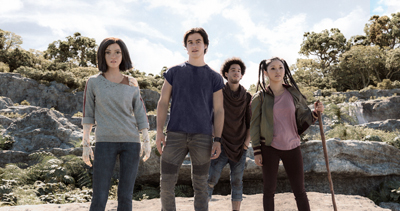 Warren says veracity was the bottom line for his work"which is why nearly everything you see on the screen began with real moves, rather than being created digitally after the fact. "Even though Alita and the other cyborgs are animated bodies, we still did it all for real, because it makes a big difference to have a person tangibly kicking, leaping and being thrown around," he explains. "Combining real stunts with performance capture technology has the ability to take audiences places they've never been before in action sequences. We're unlocking Pandora's box for the imagination with this way of making movies."
Warren says veracity was the bottom line for his work"which is why nearly everything you see on the screen began with real moves, rather than being created digitally after the fact. "Even though Alita and the other cyborgs are animated bodies, we still did it all for real, because it makes a big difference to have a person tangibly kicking, leaping and being thrown around," he explains. "Combining real stunts with performance capture technology has the ability to take audiences places they've never been before in action sequences. We're unlocking Pandora's box for the imagination with this way of making movies." Warren worked in tandem with fight choreographer Steve Brown, known for his work on Wonder Woman. Brown was pushed to think way outside even the vast action box as he faced such challenges as training a seven-foot-tall stunt performer to fight on stilts in order to digitally capture Grewishka's moves.
It was also a chance for Brown to create a wildly dynamic, original fighting style for Alita, keeping in mind that style evolved a world beyond earth's gravity. "The idea is that the way Alita fights, her whole body becomes a weapon. It's never about just her hand or her foot. Her body works as a unit, as she bounces off targets, creating momentum to make more powerful strikes," Brown elaborates.
Alita's style and skill also progresses through the course of the story as she hones her self-identity. "She starts to have even more and more confidence in her fight style. And then when she gets her Berserker body, it's like everything just makes perfect sense, and there are few limits," says Brown.
Layering the Emotion
One of the last layers of creation added was the music, including the brand new single "Swan Song," co-written and performed by double Grammy® nominee Dua Lipa. Says Dua Lipa of how Alita inspired her: "I see a little of myself in her, in both her badass spirit and our shared haircut. Alita is all about empowerment and standing up for who you are, which are two things that resonate with me."
Then there is the score by Tom Holkenborg aka Junkie XL, the Netherlands-born producer who's become a close collaborator with Hans Zimmer and a go-to for searing action. Rodriguez knew he was the one after hearing his iconic wall-to-wall score for George Miller's non-stop Mad Max: Fury Road. "Junkie XL is all about propulsive music," says Rodriguez. "His music can drive a huge action sequence but also let you into the soul of a character. I felt he was about to bring both the 'battle' and the 'angel' to Alita."
Alita was always about recombining contrasts"the battle and the angel, the real and the digital, and also the styles of Rodriguez and Cameron. For Jennifer Connelly, the final film is a union of both filmmakers' sensibilities. "You have the epic scale of fantasy that we all associate with Jim but also the playfulness, sense of fun and a little bit of the subversiveness and dark humor of Robert," she says.
As Rodriguez put the finishing touches on a film that began nearly two decades before as the dream of Cameron, the mood was anticipatory. After all the visualizing, drawing, designing, rendering, performing, capturing and refining, everyone was ready for the fully alive Alita to meet the world.
Rodriguez's only hope is that audiences emerge from theaters with an emotional connection to Alita and the movie rather than wondering how the immediacy of this photo-real world of the imagination was achieved. "At the center is always Alita's human journey," he says. "And that's also what Alita realizes. She may have lost much of her memory, but she has found her humanity, which is what counts."
Upon viewing the finished print of Alita: Battle Angel, its originator, Yukito Kushiro, could not have been more effusive. "I wanted to become a movie director and make fantastic films when I was a child. Though I was not able to realize that dream, I was able to pursue a career as a manga artist. So now seeing my manga series turning into this brilliant film, Alita: Battle Angel, is a dream-come-true for me. The visuals, the characters, the storytelling – all the factors that make this film are fantastic! I can see the passion, love and respect for my work in the film. It makes me feel that I would actually want to live in the Iron City! And I would very much love to see more Motorball scenes!"
Alita: Battle Angel
Release Date: February 14th, 2019
MORE





